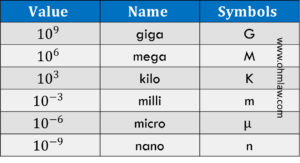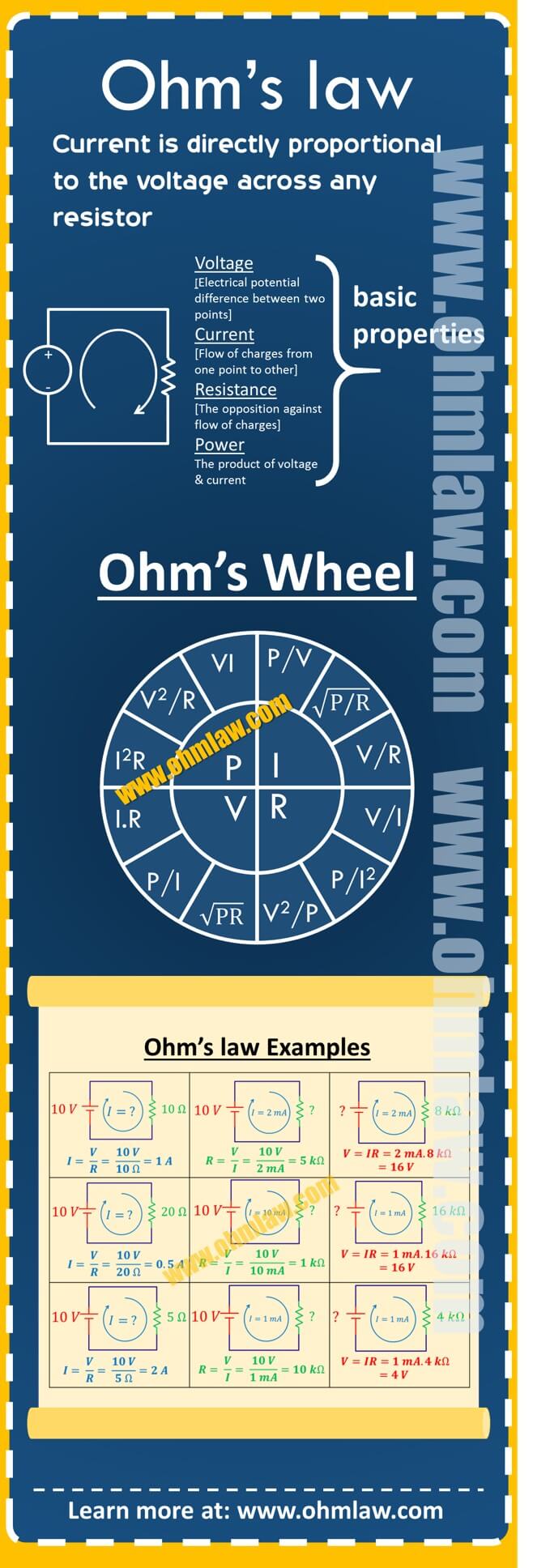Ohm’s law explains the relationship between voltage and the current flowing through resistors.
Ohm’s law: The current flowing through any resistor is directly proportional to the voltage applied to its ends.
Mathematically Ohm’s Law is given by V = IR
Where
V = Voltage,
I = Current,
R = Resistance
Ohm’s Law is widely used in Electrical Engineering for solving circuits. A circuit is the combination of voltage source and resistors forming a closed loop (Like the one shown above).
The Ohm’s law statement is experimentally derived statement. George performed various experiments on 1k ohm resistor and finally published the treatise in 1827.
- Statement of Ohm’s law
- Ohm’s law experiment
- Ohm’s wheel
- Ohm’s law calculator
- Ohm’s law formula
- Ohm’s law for Kids
- Lab report on Ohm’s law
- Verification of lab experiment with theory
- 5 Practical applications of in daily life
- Examples on the law
- Circuit diagram with 5 different examples
- Ohm’s law quiz
- Ohm’s law in series circuits
- 5 Error sources in Ohm’s law experiment
Basics of Ohm’s law: Voltage, Current, and Resistance
Ohm’s law relates three basic electrical properties: voltage, current, and resistance. Let’s understand them individually.
Voltage: We all know about the magnet which attracts the iron towards itself. A magnet does so because it has a magnetic field which is stronger in close proximity and which gets weaker with the increase in distance. Like a magnetic field, a similar electric field exists in nature. Technically this electric field is named as electric potential. The voltage or potential difference is the measurement of this electric field strength between two points.
Current: A metallic conductor has a large number of free valence electrons which continuously move within it. A voltage source connected to the conductor forces these electrons to flow from the negative terminal of the battery towards the positive terminal. The electrical current is the measure of the flow of charge.
Resistance: While the electrical conductor carries a large number of free electrons, it also contains atoms and other bound electrons. During their movement, the free electrons also collide with the bound electrons and atoms. While doing so they lose their energy. The resistance is the measurement of this opposition by which bound electrons and atoms resist against movement of free electrons.
Why you need the Ohm’s law?
Because we are practically learning the law, it is important to answer the BIG WHY. We already know that current, voltage and resistance are three major electrical properties. Let’s see how we can apply the Ohm’s relationship ( V = IR) in real life.
The electric heater
Consider a heater connected to 220 VAC wall outlet whose resistance is 20 Ω. If we want to know the current flowing through heater we can easily do it by using the equation: V = IR,
I = V / R = 220 VAC / 50 ohm = 4.4 A
To find an unknown resistor
Consider an unknown resistor to which 120 volts are applied. The current is found to be 6 A. Again by modifying original equation we can calculate the unknown resistance, that is,
R = V / I = 120 V / 12 A = 10 Ω
To find how much input voltages are provided
Let’s consider the third case where a resistive element of 35 Ω is connected to an unknown voltage source. While the current flowing through the circuit is 10 A we are interested in finding the volts associated with the input source. Luckily we can utilize the original statement for finding this, V = IR = 10 A * 35 Ω = 350 V
The role of Metric Prefixes in Ohm’s law
Metric Prefixes are the letters which are used along with numbers. At present 21 metric prefixes (approx) are in practice. Each prefix represents a specific number. The existence of metric prefixes relieves us to express very smaller and very larger number. Let’s first take a look at metric prefixes:
- yocto = 10-24 = 0. 000 000 000 000 000 000 000 001
- zepto = 10-21 = 0. 000 000 000 000 000 000 001
- atto = 10-18 = 0. 000 000 000 000 000 001
- femto = 10-15 = 0. 000 000 000 000 001
- pico = 10-12 = 0. 000 000 000 001
- nano = 10-9 = 0. 000 000 001
- micro = 10-6 = 0. 000 001
- milli = 10-3 = 0. 001
- centi = 10-2 = 0.01
- deci = 10-1 = 0.1
- unit = 100 =1
- deca = 101 = 1 0
- hecto = 102 = 1 00
- kilo = 103 = 1 000
- mega = 106 = 1 000 000
- giga = 109 = 1 000 000 000
- tera = 1012 = 1 000 000 000 000
- peta = 1015 = 1 000 000 000 000 000
- exa = 1018 = 1 000 000 000 000 000 000
- zeta = 1021 = 1 000 000 000 000 000 000 000
- yotta = 1024 = 1 000 000 000 000 000 000 000 000
Let’s say you are measuring a current having value 0. 000 001 A. Writing such number is terdious task and mentioning the 0’s to someone is even more tedious. The knowledge of metric prefix come handy here and you can simply express 0. 000 001 1 micro ampere. Of all the 21 rows there, are a few values you should keep on your fingertips:
Why they are important?
- Often resistors are rated in kilo-ohm (kΩ) and mega-ohms (MΩ).
- Current is rated in milli-amps (mA) and micro-amps (µA).
How we use them in our Ohmic circuits?
Consider a 5 kΩ (5000 Ω) resistor connected to a 12 V source. Let’s use our equation I = V/R to find the current flowing through the circuit.
I = V / R = 12 V / 5000 Ω = 0.0024 A = 2.4 * 10-3 A = 20.4 mA
The above calculation is quite tedious. For complex calculations, it might happen to be troublesome.
There is an alternative way to deal with prefixes. While mA represents 0.001, it is inverse of kA. 1 mA = (1/kA). We can use this reverse technique:
- milli = 1/kilo
- micro = 1/Mega
- nano = 1/Giga
Let’s apply this rule to the previous case:
I = V / R = 12V / 5 kΩ = (12V / 5Ω) m = 20.4 mA
A beginner might confuse these calculations. However, you can master them after some practice.
Ohm’s law and the Power
While voltage, current, and resistance are three basic electrical properties the fourth player is power.
How can we relate power with other three properties? Joule’s first law answer it.
James Prescott Joule performed various experiments on conductors and found that amount of heat generated in conductors is directly proportional to the square of current multiplied by the resistance.
Mathematically,
P = I2R
We can use other equations of law to achieve 12 different formulas.
Let’s summarize the above discussion into the infographic:


